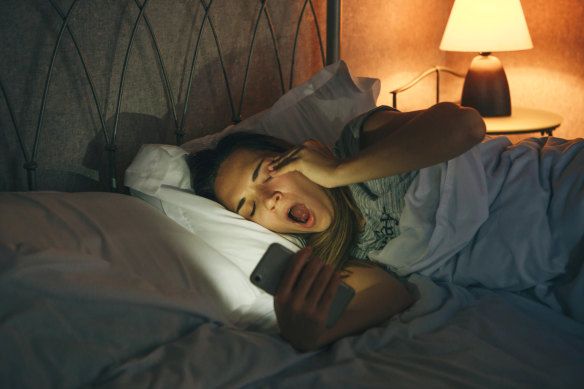The pros and cons of watching TV in bed
By Lisa Strauss
If you have insomnia, the usual recommendation is not to watch TV in bed. There are at least five reasons for this advice.
Conditioning: The modern bedroom is a media room, outfitted with laptops, phones, tablets, e-readers, TVs and smart speakers. These are in addition to our books, work papers, pets, kids, takeout containers, lotions, puzzles and piles of unfolded laundry.
But one of the best supported components of insomnia treatment, stimulus control therapy (SCT), proscribes all activity in bed except for sleep and sex. When we reserve the bed for sleep, bed is hypothesised to become a strong conditioned cue - a green light - for falling asleep.

Screens can be disruptive to sleep.Credit: iStock
SCT is also thought to encourage the formation of helpful associations between the bed and peaceful drowsiness while breaking harmful associations between the bed and anxious wakefulness.
Content: There is no scientific consensus yet on the effect of screen content on adults’ sleep, but patients regularly tell me that certain programs stimulate emotions and thinking that interfere with their sleep. Shows can also be compelling enough to keep my patients watching beyond when they would otherwise be asleep.
Biological rhythm: Late-night light conveys a false sunlight signal to the biological clock and suppresses the darkness hormone melatonin, effectively shifting our internal time zone westward.
Environmental intrusion: Volume fluctuations and flashing lights from the TV can be jarring when we’re awake and can wake us up if we’ve fallen asleep. Light is also a stimulant. It doesn’t take much sound to disrupt sleep.
Risk of falling asleep prematurely: Many of my exhausted patients collapse into bed shortly after work to watch TV. The TV lulls them to sleep early and then they can’t sustain sleep through the night because sleep drive, like any appetite, has its limits. Their sleep fragments, and they may lie awake for long periods in the middle of the night or wake too early.
Now let’s look at the other side of the coin. There are some good arguments in favour of watching TV in bed.
Conditioning: What if TV in bed is itself a conditioned inducement to falling asleep? I’ve had more than one patient who stopped watching TV in bed because they heard they were not supposed to, and stopped being able to fall asleep. Many others confess that they rely on it.
Content: Now that TV is on demand, we can carefully curate what we watch. A David Attenborough nature documentary is not Black Mirror, the modern-day Twilight Zone. Having something soothing to focus on (“cognitive refocusing”) can drown out our default thoughts. Some people contain their thoughts more effectively when they watch something than when they engage with other foci. To use nothing at all would leave them defenceless.
Companionship: Loneliness is harmful to sleep. Stories and their characters can be our companions late at night.
Soothing sound: Perhaps relatedly, a few of my patients like to listen to the TV at minimal volume to fall asleep. They are comforted by the drone of human voices the way others are comforted by rain sounds. Conceivably, “articulatory suppression” of thinking is at play.
Pleasure, rest and autonomy: It can feel good to claim some time for oneself (or with a partner) in the comfort of our bed at the end of a long day attending to obligations and others’ needs. The content we choose caters to our unique longings and interests.
While there are no perfect compromises, here are some customised guidelines for patients with insomnia who want to enjoy good sleep and some TV in bed. These guidelines are not a substitute for individualised health care.
Guidelines for watching TV in bed
- Enjoy most of your TV time in another room, coming to bed to watch just a little more once you start to feel drowsy.
- If bed and only bed will do, change up the environment for sleep vs. wakeful time. For example, watch TV on the side of the bed opposite the one you normally sleep on (left vs. right). Move to your side of the bed when you start to feel drowsy.
- Choose your content thoughtfully. Switch if it’s too stimulating.
- If you can enjoy non-screen-based activities instead of TV beginning two hours before sleep, that’s optimal. See whether you can find time to enjoy your shows earlier.
- If you strongly prefer TV during those hours, blue block the light and markedly lower the TV’s brightness. This advice applies regardless of whether you are in bed, and ideally to all light. Keep screens at a distance from your face.
- Avoid watching TV to get back to sleep in the middle of the night.
- Put the TV on a timer so that it shuts itself off and doesn’t keep waking you up.
- Prop up your body or walk around or switch activities as needed to stay awake until a later hour that you have found supports a reasonably consolidated night’s sleep.
- Audiobooks or listening to shows could substitute for watching TV if you need sound or companionship to fall asleep but want to avoid screens.
- To help with loneliness, some of my patients have found friends through activities that meet weekly, such as card games, church or temple committees, or hiking groups. Others benefit from a little therapy to effect enough improvement in social anxiety, self-esteem or social skills to embolden them to reach out to others.
- Overwork and insufficient time for oneself can lead to a rebound at night. This rebound might manifest as postponing sleep in favour of activities such as binge-watching. Strive for more balance day-to-day so that sleep is not what’s sacrificed, leaving you even more tapped out and vulnerable to maladaptive habits.
Lisa Strauss, PhD, is a clinical psychologist. She specialises in sleep disorders.
This article was first published in The Washington Post.